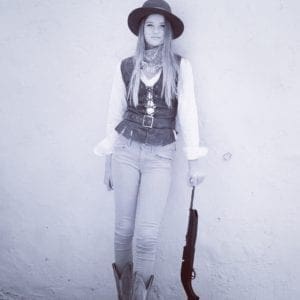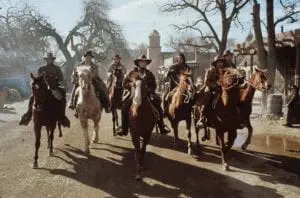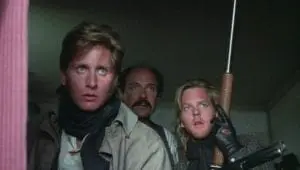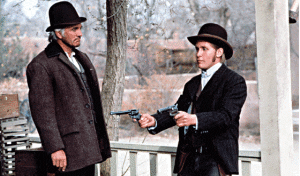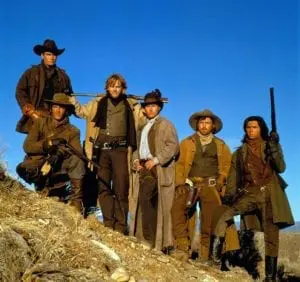Young Guns
"Six Reasons Why the West Was Wild"
(1988)
starring Emilio Estevez, Kiefer Sutherland, Lou Diamond Phillips, Charlie Sheen, Casey Siemaszko and Dermot Mulroney
PODCAST:
'80s Movies:
A Guide to What's Wrong with Your Parents
YOUNG GUNS:
Does Young Guns share some responsibility for America's gun obsession?
Teen William H. Bonney is hired by cattle rancher John Tunstall to be a part of his security team, young men called the Regulators. When Tunstall is murdered by a rival gang, the six swear revenge, and kill some of the gang, starting a war and turning them all into famous outlaws, most notably Billy the Kid.
Why it’s rad:
“A cowboys-as-hunks adventure.” – Rutland Herald
Young Guns revitalized the Western by casting Brat Packers whose chumminess extended to the audience.
Why it’s So '80s:
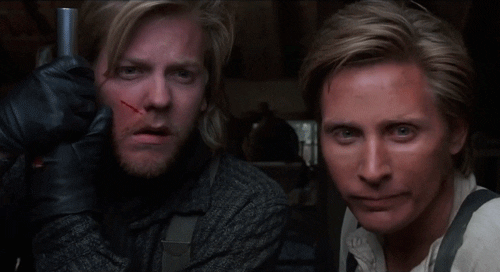
The TODAY Show described Young Guns as “St. Elmo’s fire with horses.” Indeed, it’s a cast that is iconically ‘80s: Brat Pack captain Emilio Estevez with teammates Kiefer Sutherland and Charlie Sheen. Lou Diamond Phillips, hot from La Bamba and who became "pals" with Estevez and Sutherland during filming, became inducted into the Brat Pack as a result.
Young Guns didn’t have the MTV soundtrack that it’s sequel did, but the score was definitively, if not oddly, ‘80s. Electric guitar, saxophone and synthesizer can be heard in this western score.
Mostly, though, the ‘80sness of Young Guns is its theme of youth uprising, rebellion and friendship. Teens of the ‘80s had dissent and rage running through their bones. Teens responded to the punk and heavy-metal music of the decade, but weren't really sure why they felt oppressed, and many placed the blame at those around them. But by 1988, films depicting high schoolers putting parents and principals in their place had run its course. The film shows a time when a bunch of kids (“none of them are older than 21”) fought back against grown-up corruption and political nonsense.
Young Guns pointed the way to the REAL reason for youth agitation. Gen X'ers were kids born and raised in the age of Watergate and Iran Contra, a time where it felt like adults were lying and cheating without any consequences. Most kids of the '80s probably couldn't identify and verbalize it at the time, but feeling like kids are being held to a different standard than the adults who are breaking the rules -- and feeling like they can't do anything about it -- is a level of frustration that Young Guns tapped into. The Regulators blowing away dishonest adults who underestimate them provides a fantasy fulfillment moment for the film’s youthful audience.
What’s your damage?

As much as we love Young Guns,
it glamourizes gun violence and
turns one of history's most murderous outlaws into a hero.
Guns, aren't they AWESOME? Young Guns promotes gun worship, even the title promotes the weapons as something sexy. In the film, guns are rarely used for self-defense or hunting, they're used for revenge: to threaten and to kill. It all starts when the Murphy-Dolan gang ("the bad guys") shoot up the Regulators leader, John Tunstall. When the boys are deputized to serve warrants to the murderers, Billy instead subverts justice by planting bullets in the suspects himself. Dick, Doc, and the rest are aghast at Billy's itchy trigger finger, but it doesn't take much for them to join in. ...and boy, isn't it FUN? Yes, Young Guns depicts history, and guns were a survival part of the environment in the Wild, Wild West. But, in portraying Billy the Kid as a hero, it subconsciously places guns, gun violence, and shoot-first-consequences-later as an ingredient to masculinity - this is what real men do. [Note: Alex McSween, who doesn't pack heat and waves a white flag, winds up being riddled by the bullets of a Gatling gun (untrue to history)...the implication: if only he'd carried a weapon, he'd at least have gone out as a man.]
Part of that hypermasculine guns-are-cool perception comes from the fact that Young Guns makes the Regulators aspirational characters. Playing some of America's most famous outlaws were the coolest actors of the day: beautiful young men who were dating the most desirable actresses, driving the sleekest cars and attending the most elite parties.
By doing so, it creates another aura: the bad boy. Films of the '80s were constantly serving up the message that the bad boy is sexy and unattainable, but just needs love. If the right woman fell for him, and he for her, her love could fix him...change him. But girls, mmm-mmmm, these are the boys you WANT. The audience roots for Doc to win Yen Sun's heart - but remember, he snaps at her, yells at her, and she is visibly afraid of him at one point. Somehow, though, that one dance they shared and the flowers he tried to give make her fall in love with him - so much so that she runs into a burning building just to hug him. *sigh*
Behind the Scenes
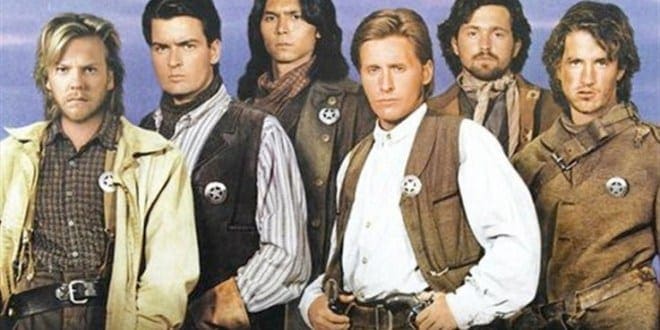
At the age of 10, screenwriter John Fusco became intrigued by Billy the Kid after seeing the famous tintype of the outlaw. Fusco said, "This little 5-foot-4, rodent-faced character (in the photo) just didn't correspond with the legend of Billy, the noble bandit dressed in black--Johnny Mack Brown, Robert Taylor."
Fusco grew up with a fascination with the Kid, collecting pieces of information as he grew, thinking maybe one day he’d write a novel.
He was motivated to write Young Guns while visiting the gravesite of Billy the Kid in Fort Sumner, N.M. He’s quoted in the book “The Quick, The Dead and The Revived: The Many Lives of the Western Film:” “He’s buried there with some of his regulators, and the epitaph on the tombstone is one word: 'Pals.' When I saw that years ago, I knew I had my theme for Young Guns. And there’s a point in the movie where the gang is in jeopardy of breaking up, and Billy the Kid, trying to keep them together, says, 'you get yourself three or four good pals, then you’ve got yourself a tribe. And there ain’t nothin’ stronger than that.' It’s a key moment in the story and really defines this band of brothers.
Fusco said he wrote the screenplay with Bon Jovi’s “Wanted: Dead or Alive” in the background as “mood music.” Star Emilio Estevez, who was introduced to Jon Bon Jovi by his The Breakfast Club co-star Ally Sheedy, asked if the film could use the song to play over the end credits. However, Jon didn’t think the lyrics matched the film and said he would, instead, write a new song. It didn’t happen in time for Young Guns. [“Blaze of Glory” (heard in montage video at top) did come together for Young Guns II; the single hit No. 1 on the Billboard Hot 100, it launched a solo album of Young Guns-themed songs by Jon Bon Jovi, and came to identify both of the Young Guns movies.]
Writer John Fusco had only one major screenwriting credit, but if an instant cult classic exists, it was Crossroads. Ralph Macchio starred as a teen blues traveler, based on Fusco's experiences doing the same.
Fusco was a fan of Westerns. He wrote in True West magazine, “In the late ’80s my agents begged me not to pitch my Billy the Kid idea because the Western was 'dead.' I defied common sense, went off and wrote it on spec. Glad I did.”
Fusco knew, though, that casting was key to the film's success. He said, "I wrote Young Guns on spec because I really believed that the young age of these guys historically, the whole legend of Billy dying at 21, would attract a young staple of stars, and that would be the game-changer."
In his 2016 book “The Quick, The Dead and The Revived: The Many Lives of the Western Film,” author Joseph Maddrey asserts that the resurgence of the Western came about because the U.S. was out of political turmoil (the end of communism in Russia, the Berlin Wall came down), and so Americans could feel “safe and confident for the first time since the end of World War II….For the time being, America seemed to have regained control over its own destiny. As a result, it was possible for Hollywood to explore the western myth with renewed vitality and earnestness.”
Young Guns was the first movie released by Morgan Creek Productions. The success of the film ($45 million against an $11 million budget) made it the 22nd biggest hit of 1988 and led to a sequel and the resurgence of the Western.
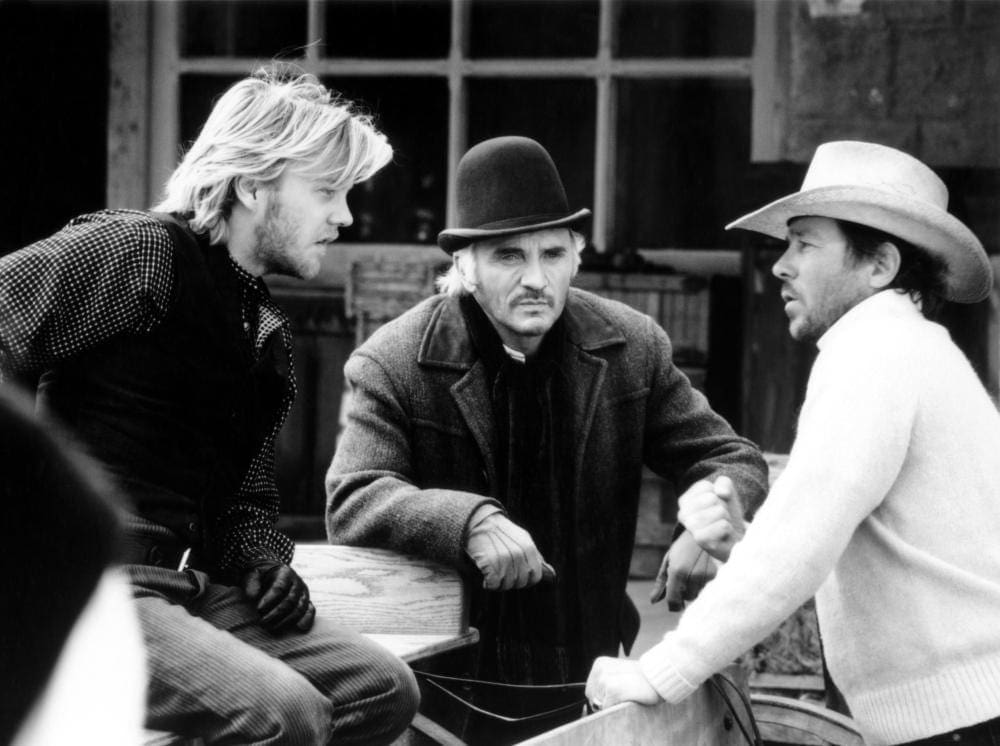
CASTING
This was the Brat Pack movie of the year, Emilio Estevez, Keifer Sutherland and Charlie Sheen in the leads. Casey Siemaszko didn’t have the fame level of a Brat Packer, but was in their films (Back to the Future, Stand by Me, Class and Biloxi Blues.) It was the mainstream breakout film for Lou Diamond Phillips, who had made a splash with La Bamba, followed by a Golden Globe nomination for his role as a gang member in Stand and Deliver.
This was Dermot Mulroney’s first big role in a Hollywood movie, after doing after-school-special type work. While he worked consistently, he didn’t become a household name until My Best Friend’s Wedding in 1997.
It’s hard to imagine anyone else playing William H. Bonney the way Estevez did, however, he wasn’t the first choice. “Sean Penn was originally offered the part of Billy the Kid,” said Lou Diamond Phillips. “He couldn’t do the movie because he was in jail for punching a photographer.” [Editor’s note: Sean Penn’s most famous brush with the law was the one Phillips mentioned, but that happened in 1985. We believe Phillips was referring to the time when Penn was sentenced to 60 days in jail for beating up an extra on the set of Colors.
Estevez said he signed on, excited by the idea of an ensemble western and loving Fusco’s script. [He was not happy with the final product. He said, “John Fusco wrote a magnificent script, but then it was turned into what I call Hollywood’s first heavy-metal western. It was just an excuse for a personality piece featuring all these young actors, and I was very disappointed.”]
Patrick Swayze was originally offered the part of Dick Brewer. Phillips said Swayze told him he passed because he thought he needed to “get away from the whole Brat Pack thing.”
Alice Carter ("Yen Sun") made her feature film debut in Young Guns. She went on to become an acting teacher.
Pat Garrett was played by Patrick Wayne. As in, son of John Wayne. In Young Guns II, the part of Garrett was expanded and Wayne was replaced by William Petersen.
Susan McSween is played by Sharon Thomas. As in, Sharon Thomas Cain – the wife of the director. She is the mother of Superman actor, Dean Cain.
Christopher Cain is a writer-director who is known for westerns, and Young Guns helped secure that place in cinema history. Born in South Dakota, he directed the Robert Duvall-Glenn Close western The Stone Boy in 1984. After Young Guns – which some might describe as being the teen version of The Magnificent Seven – Cain directed five episodes of “The Magnificent Seven” TV series in the late ‘90s. He also directed the George Strait movie Pure Country and Pure Country 2.
Cain is known for working with actors from previous projects. He directed Emilio Estevez on That Was Then…This is Now, an S.E. Hinton film adaptation. He later cast Casey Siemaszko in his 1997 film Rose Hill.
Dermot Mulroney graduated from Northwestern University in 1985, moved to Hollywood, and – like some sort of actor’s fantasy – started booking work right away. Young Guns was cast in 1987. He lists Young Guns as one of his top three favorite movies he’s made [the other two are The Grey (2011) and Long Gone (1987)].
Sutherland and Siemaszko worked together previously in Amazing Stories (1985), where they were directed by Steven Spielberg. They worked together again on Stand by Me (1986): Sutherland played bully Ace, and Siemaszko was Billy Tessio, a member of Ace’s gang and older brother to Vern (Jerry O’Connell).
Tom Cruise is the first person shot by Billy the Kid from McSween’s house. Cruise and Estevez were friends. Cruise was visiting Estevez and decided he’d jump in on a scene, asking if he could get shot – he is the first cowboy shot in that scene.
Estevez also jumped in on that scene as one of the gang shooting the McSween house, for a kick.
Randy Travis is the soldier firing the Gatling gun that shoots McSween to death (in real life, a Gatling gun was brought in for the shootout, but it was not the weapon that killed McSween).
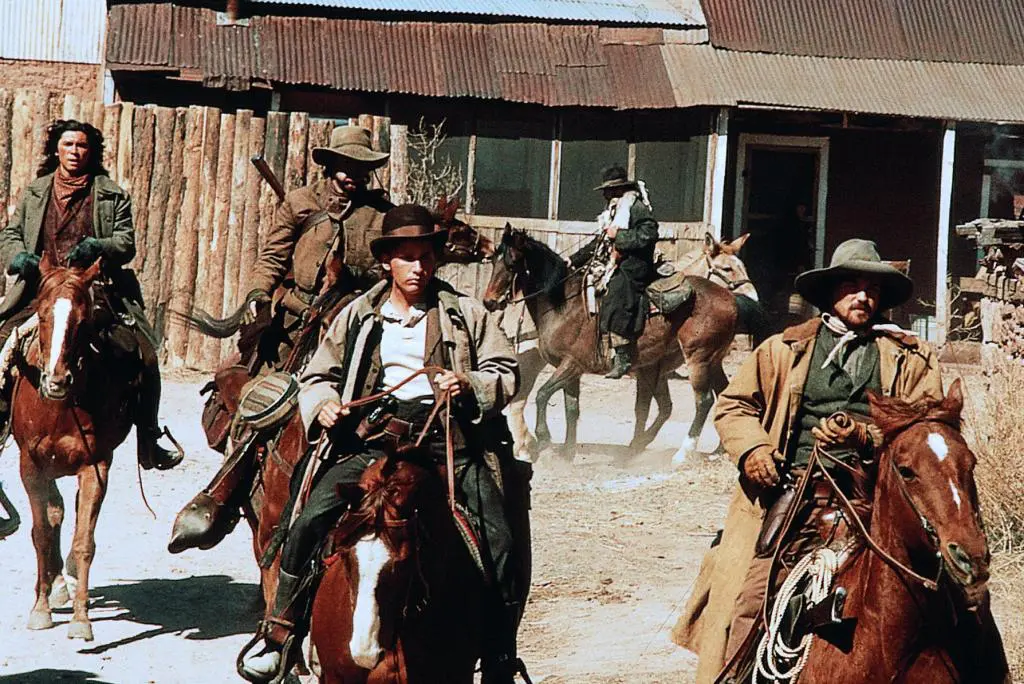
RESEARCH AND TRAINING
Emilio Estevez researched Billy the Kid to try and understand him. He said, "Billy's dad had died and he killed a man at age 12 or 13 for insulting his mother," he said. "Billy was an angry soul. He was abused as a child."
Moreover, Estevez said he learned that Billy was “the opposite of who he really was. My image was he was this kid who shot people in the back, hard drinking, didn’t give a damn about anyone but himself. Quite the contrary, this was a guy who cared about people, who found a father figure in John Tunstall, and when he was assassinated by the corrupt politicians – the Irish mob that was running the town of Lincoln – he said, 'wait a second, something’s not right here. No. 1: I’ve got to get revenge, and No. 2: this ring’s gotta fall.' He went on this crusade to bring them down and he did."
Casey Siemaskzo told Moviehole, "I did some reading about Charlie Bowdre prior to working on the show, but was able to get any info I needed from John Fusco, the writer and producer, who was always close at hand."
Kiefer Sutherland said most of his peers did conduct a lot of research on their characters, but he decided against it. Sutherland was offered books by Fusco, but said he chose to approach the role "with imagination and take dramatic license rather than make a docu-drama."
To get into cowboy shape for the film, the cast had six weeks of horseback riding lessons. Estevez said, “Everyone worked out and got in shape for this film, just because of all the riding and the running around."
During their training, the boys would play tag on horseback. One day, Cain yelled at them to stop, well, horsing around because they riding them too fast.
Charlie Sheen said he had a whole workout in the morning, and the implication is, that he would lead the band of buddies.
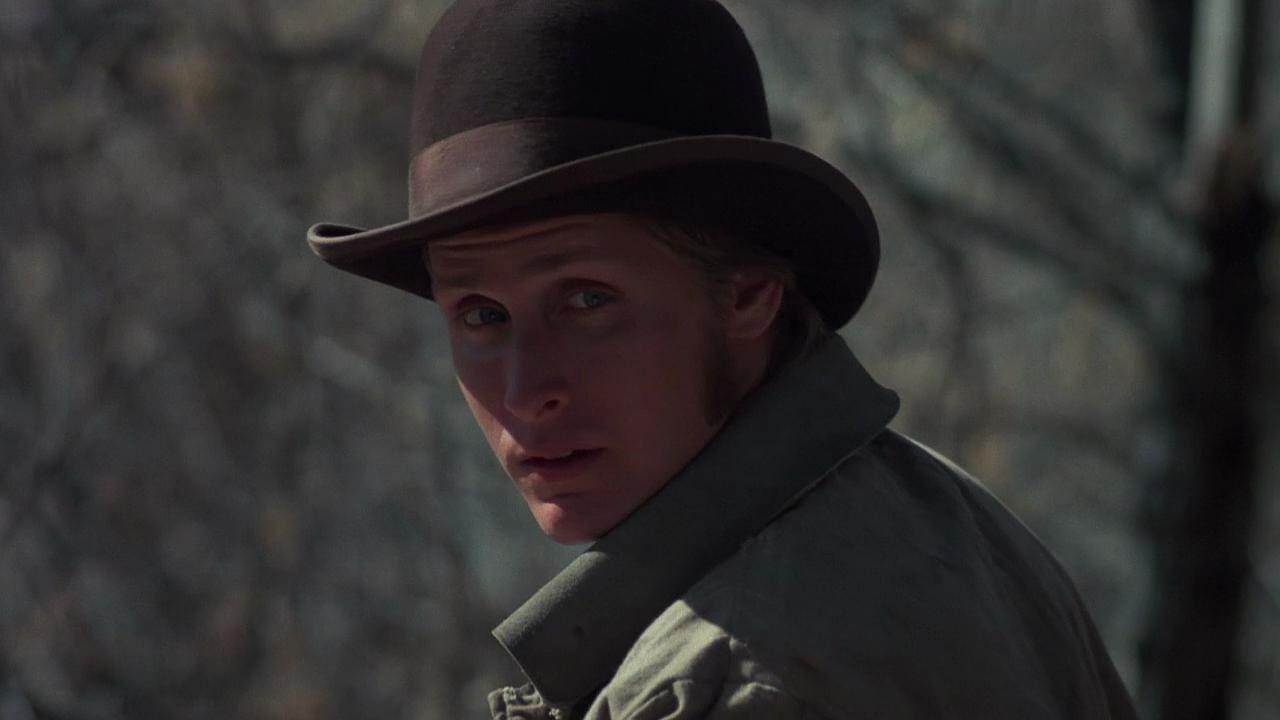
EMILIO ESTEVEZ AS BILLY THE KID
Emilio Estevez was drawn to the idea of being a gunslinger, which he found equally appealing and repulsive: "On one hand, I've always wanted to blow people away in a movie. I really have. True confessions. There were a lot of killings where the people cheered...The first reaction is elation because the audience is responding. And then the second reaction is 'I have this responsibility and, boy, how sick that is.' "
Screenwriter John Fusco said Emilio Estevez “lived and breathed The Kid.”
Estevez said he had to unlearn his actor’s training for the role because Billy doesn’t think, he just reacts. “As actors, we’re always taught to ‘think on camera.’ I really had to reverse that process, and the director Chris Cain, really stayed on me about it, saying, ‘I have to cut because I caught you thinking!’ We’d do it over and over again until Billy was all reactive."
Young Guns was the last role Estevez took in which he played “a kid.” At the time, he said it was the role he was most proud of as it was “full-bodied” and had an arc.
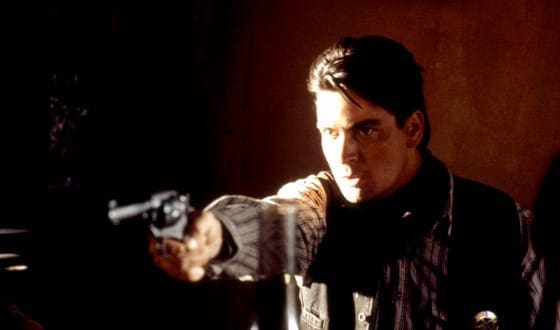
CHARLIE SHEEN AS DICK BREWER
Charlie Sheen did not enjoy the horseback riding. “I didn't trust the animal. My horse, Blaze, was a real piece of work. He didn't like me. It was kind of a hate-hate relationship," Sheen said. "He was a great rehearsal horse. But the minute he heard the word action, which he understood, I was dead in the water. He blew more takes. I thought I had a good performance, good energy and the horse is off in the can."
Sheen wasn't the only actor who didn't have a symbiotic relationship with their horse. Sutherland didn’t care for his horse and kept asking the horse trainers if he could trade with Phillips.
Charlie Sheen's proclivity to drugs, prostitutes, and breaking the law make it amusing to see him the leader and moral compass of the Regulators. At the time, it appears he was living life a little straighter. Fusco wrote, “Charlie Sheen was the only sane one. He was always dragging us out of border bars and restoring order to bad situations. Not sure if he was just in character as the foreman Dick Brewer, but he would literally yell 'Regulators' and herd the guys out of trouble.”
That could be that before filming Young Guns, Sheen had met one of his heroes who (temporarily) influenced him to live a vice-free life. Sheen told Premiere magazine that he had a drink in his hand when introduced to U2 frontman Bono. Bono told him that he and his band-mates didn't consume alcohol. "He is a hero of mine," said Sheen. "To hear it come from him was all I needed to hear. I had come to a peak. It was that or 'See you later.'
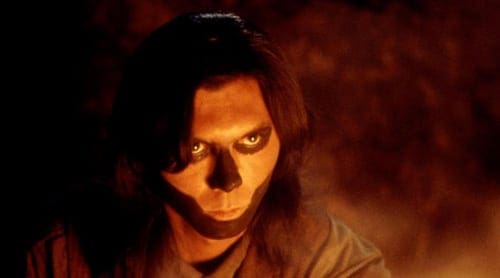
LOU DIAMOND PHILLIPS AS JOSE CHAVEZ Y CHAVEZ
Lou Diamond Phillips discussed how his first casting meeting went. "I read the script and go into this meeting, and I’m like, 'Oh my gosh this is wonderful, this is amazing, oh my gosh this is incredible!' And, I’d just met Kiefer Sutherland a couple of weeks before and we were, 'Oh, we gotta do something together!' I knew Kiefer was being offered the part of Doc Scurlock …(aside) I got this meeting set up with Joe Roth, John Fusco (who is from Connecticut and wrote it), Chris Cain our director, and Paul Schiff, the co-producer on the Fox lot. I read the script, it’s great, but what they haven’t given me are the audition scenes – I don’t know scenes they are. So, I think, okay, I’m going to pick a couple of scenes that I think are really good and I’m going to go in there and knock their socks off. So, we go in and we chat for 15-20 minutes and they’re being so nice to me, so kind. I’d just come off of auditioning for six months and couldn’t get anywhere, and these guys are being really warm. So, there comes a lull in the conversation and I say, 'So, I’m sorry, they didn’t tell me what scenes you wanted to see, so I picked a couple. Who am I reading with?' And, Chris Cain, the director, kind of looks at me. And, he looks at Joe Roth, the producer. Looks at Fusco, the writer. And now they’re all kind of smiling and nodding, and I’m getting really nervous. And Chris goes, “I don’t think you understand, Lou. The part is yours, if you want it.” This is the first time I realized I’d reached a plateau in Hollywood. I thought, I guess I’ve arrived!'"
Jose Chavez y Chavez is Spanish-American. In the film, his ethnicity is changed to be Native American and Mexican. Given the effort to maintain authenticity, we wondered if Chavez's story was fused with Fred Waite, a Native American Regulator who was later became a politician and was elected as Governor of the Chickasaw Nation. Screenwriter John Fusco told @80sMovieGuide on Twitter: “Chavez y Chavez family had native blood. But, yes — Fred Waite was Chickasaw and I wanted the indigenous element in the posse.”
Making Chavez a Native American, though, may have changed Fusco’s life. Through the experience of filming the movie, he said he became friendly with a Hopi woman who introduced him to different people in the community. Additionally, his reverence for “Indians” inspired Paramount to offer Fusco a screenwriting gig – the idea goes into the kinda racist, exploitive, bad idea category, so Fusco instead wrote Thunderheart. That led to his incorporating more Native American representation into films such as Hidalgo, Spirit: Stallion of the Cimarron, and Robert Redford’s narration script for the documentary Incident at Oglala. More than 800 Native Americans have been employed on Fusco’s projects. For the record, Fusco is Italian-American. (Also, Lou Diamond Phillips is neither Native American nor Mexican, he’s Filipino-American.)
Lou Diamond Phillips said being cast in the film granted him Brat Pack status, and he told AV Club he’s still the only ethnic member of the famed Young Hollywood crew that ruled the ‘80s: “It’s amazing how iconic that role’s become. It’s not quite as much as people screaming “Ritchie!” [Valens, the singer he plays in La Bamba] at me, but I do get people yelling, “Mexican Indian!” [Laughs.] I love those films. And they’re films that have stood the test of time. They’re still entertaining, they’re still good, and people still watch them. There’s a whole generation that… well, it’s one of their favorites. And it was the moment in time where I felt like I’d made it. My first three films in Hollywood were La Bamba, Stand And Deliver, and Young Guns, and they’re probably the reason that I’m still here today. Stepping onto that set with Kiefer, with Emilio [Estevez], with Charlie [Sheen], with Dermot [Mulroney] and Casey [Siemaszko], suddenly I went, 'Okay, I’ve arrived. I have been granted access to this echelon of young actors in Hollywood.'"
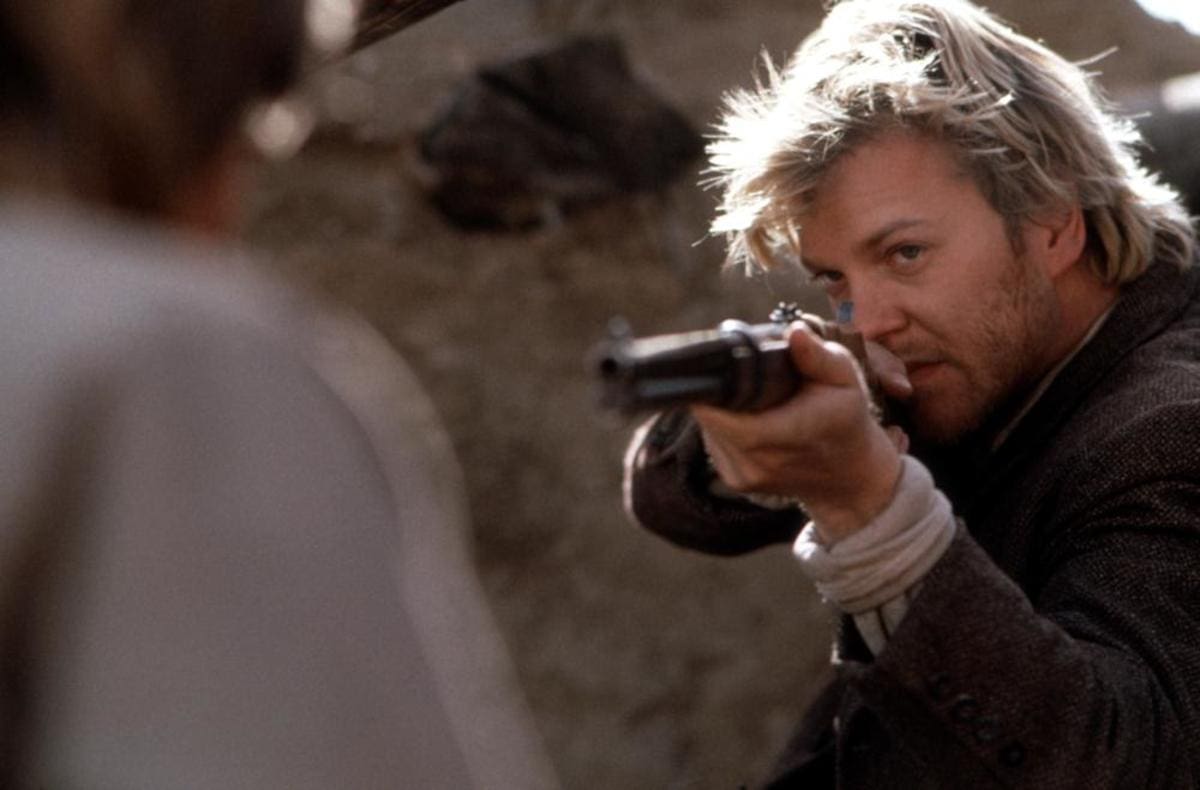
KEIFER SUTHERLAND AS DOC SCURLOCK
In 2016, Keifer Sutherland told 11th Hour Online that getting the part in Young Guns was a big coup: “Everyone wanted to be in that movie. Westerns just weren’t being made during that time. So everyone came on that set. Tom Cruise is in the first Young Guns. We put him in a beard and shot him off the roof. Jon Bon Jovi was also in the movie. We were all buddies with him back in those days. We put him in a beard and shot him off the roof too. Not many people know that. And after we wrapped the first movie, we all went out drinking. Jon Bon Jovi was all in Emilio’s ear about doing the soundtrack for the sequel. Emilio kind of shrugged it off. We didn’t know if there would be a sequel. But Jon sat over in a corner, I don’t even think he was taking shots with the rest of us, and he was scribbling on a napkin all night. By the end of the night, he had three napkins, and on those three napkins he had written the song 'Blaze of Glory.' Emilio had those napkins framed over his mantle for a long time.”
Sutherland and Lou Diamond Phillips became close friends during the filming of Young Guns. “Kiefer and I got very tight; there was an obvious chemistry from the beginning,” Phillips told AV Club. “Kiefer’s still a dear friend. I’ve had an immense amount of respect for him from the moment we met, and we’ve done five projects together since then.
Sutherland and Phillips played a lot of practical jokes on Estevez during Young Guns. They kept the hijinks going after filming ended, having a COW delivered to Estevez on the set of his next film. [Estevez got Sutherland back during Young Guns II. In a scene where Sutherland is soaking in the bathtub, Estevez slipped a candy bar in the water. As they were shooting, the chocolate candy bar rose and emerged from the water.]
Sutherland and Phillips are still very good friends. Sutherland said, “I don’t get to talk to Lou as much as I’d like, but we do keep in touch and we are certainly still friends.”
Sutherland was 21 when filming Young Guns. He was married to actress-producer Camelia Kath, who was 12 years older than him. The two had a daughter together, Sarah, who was born during the filming of Young Guns (keep reading to see how Cain worked around the day Kath gave birth). Additionally, the barely old enough to drink Sutherland was a stepfather to Kath's 11-year-old daughter, Michelle.
On more than one occasion, Sutherland has declared Young Guns the most fun film experience he's ever had. He told AV Club, "The first Young Guns was the most fun I’ve ever had on a film. We were shooting in Santa Fe, New Mexico, most of our stuff was in the day, and it was winter, so there was only eight hours of daylight, so we had a very quick schedule. I had never gone to college, I left school at a really early age, and all of a sudden I’ve got six really great friends hanging out with me every night. And we were a really tight group, and we just had an absolute blast...I think the second film is probably a better film, because I think we didn’t have as much fun on it. [Laughs.] But the first one was an absolute blast. And it was nice for me to play a character that wasn’t a complete asshole!"
On another date, he told Yahoo about the bond the men formed, just by having down time together while shooting on-location: "We hung out in the bar together, we hung out in the restaurants together. We were really good friends. And, it kind of felt like we had a gang, which was cool.”
Weird trivia: In trying to break up Murphy’s criminal enterprise, Billy and McSween try to figure out how to contact President Rutherford B. Hayes. Kiefer Sutherland’s great-great-grandmother was President Hayes’ third cousin.
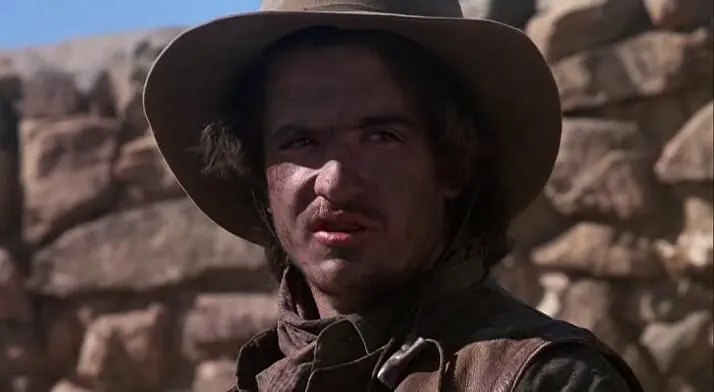
DERMOT MULRONEY AS "DIRTY STEVE" STEPHENS
Little is known about “Dirty Steve” Stephens, but he is on record as taking part in the Blazer’s Mill shootout which ended in the death of Buckshot Roberts.
Dermot Mulroney wanted Dirty Steve to wet his pants when he gets shot – director Christopher Cain nixed that idea. Mulroney also proposed Dirty Steve get shot in the knees to make it all the more dramatic and painful.
The actors and crew state they had no idea there'd be a sequel. However, Mulroney told Movieweb something different: "They knew that it was going to be a blockbuster. They were already planning Young Guns II.”
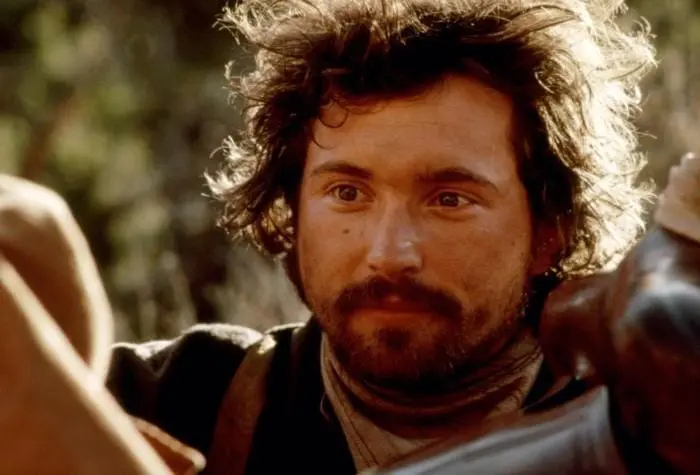
CASEY SIEMASKZO AS CHARLIE BOWDRE
Casey Siemaskzo did read up on the real Regulator he portrayed, but wasn't overly worried about it. He said, "I did some reading about Charlie Bowdre prior to working on the show, but was able to get any info I needed from John Fusco, the writer and producer, who was always close at hand."
Like the rest of the cast, Siemaskzo recalls how much fun making the film was: “Young Guns was a hoot. Great location and we were outdoors most of the time. I LOVE being outside and on horsies to boot! Can’t beat it. Fun cast too.”
But really, it was about the friendship. "Good times. Lots of fun with my fellow cast members. Late nights at the bar, skiing on the off days and lots of guitar playing," he told Moviehole.
Siemaskzo continues to act, and has a successful voice-over career in commercials and video games.
TIDBITS FROM THE SET
John Fusco wrote in True West magazine, “I loved working with the “Young Guns,” but it was the Old Guns, like Jack Palance, James Coburn and Brian Keith, who made it a true Western experience.”
When Murphy finally gets shot to death, Jack Palance gives quite the death scene. The cast noticed and joked about how the legendary actor drew out and “milked” the moment. (Watch the clip above to see if you agree.)
In one of the takes when Buckshot Roberts gets off his mule, Brian Keith fell on his back and couldn’t get up because of the heavy clothes. Phillips said he looked like a turtle on its back.
Young Guns shot in and near Santa Fe, N.M., including Los Cerillos and at El Rancho de las Golondrinas’ Sierra Village.
The poem Doc is quoteth-ing is Edgar Allen Poe’s “The Raven.”
Doc mentions dancing the Fandango. That’s a Spanish courtship dance where the couple never touch.
The gun props used in the film are pretty close to the real thing. Estevez went out on his own to get a gun similar to what was used by the real Billy the Kid. According to the Internet Movie Firearm Database, "The real Billy the Kid carried a Colt 1877 DA Thunderer revolver in .41 Long Colt, but since this is an uncommon blank round, the similar Colt 1877 DA Lightning in .38 Long Colt was used for simplicity." For info on all the guns seen in the movie, go to imfdb.org.
Members of Hell’s Angeles were employed as security detail. They show up on-camera at the sleazy shack where Billy goes to serve Henry Hill his warrant.
According to the DVD commentary, the Henry Hill shootout resulted in some real-life minor injuries. When fired, the fake prop guns released a debris with a clay-type substance, which struck Estevez and Mulroney. The horses were spooked by the loud noise, and Sheen’s horse broke into a run that shook his feet out of the stirrups, so the actor was clutching the saddle horn to stay on while yelling, “Whoa! F—in whoa!
The actors enjoyed singing and playing music during their hours. When they were drunk, they’d goad Phillips to sing “La Bamba.”
The scene where Charlie goes to the brothel and asks the older prostitute to hold him seems a little bizarre, it plays like he wants to be held by a mother. The script reveals that the prostitute is Charlie’s mother, who doesn’t recognize him, and Charlie is saying goodbye in his own way, knowing he’ll probably die. A scene is cut where the boys are leaving the brothel and Dirty Steve asks Charlie about what he assumes is a sexual encounter, and Charlie retorts, "That's my mother!"
Look closely at the peyote scene for a few real-life tells:
-
“Dirty Steve” asks his horse if he saw the chicken and then fires the gun: you can see the horse wrangler’s hands holding the horse’s reins to keep him still when the gun goes off.
-
Lou Diamond Phillips is scared of heights, so Chavez moving slowly on the rock was partially due to the fact that Phillips was freaked out.
-
Peyote can make the user throw up, however, Charlie is vomiting cream of mushroom soup.
-
Kiefer Sutherland’s wife had their baby while this was being filmed, so when the gang is traveling through the Native American village, high as a kite, notice that Doc is wearing a bandana high on his face…they subbed in a stand-in so Sutherland could be with his wife during childbirth.
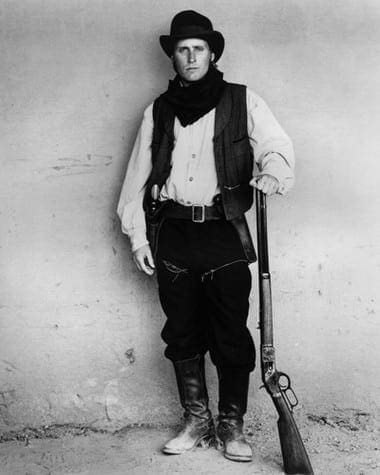
THE MOST HISTORICALLY ACCURATE MOVIE ABOUT BILLY THE KID
William H. Bonney is just one alias of Billy the Kid. His real name was Henry McCarty. He also used the alias Henry Antrim. He lived 1859-1881, killed by Sheriff Pat Garrett in Fort Sumner, New Mexico.
The movie is true-ish. Historian Dr. Paul Hutton declared Young Guns the most accurate of all the Billy the Kid movies, and there are many. In fact, at least 52 film/TV movies are about or include the character of Billy the Kid (this doesn’t include TV series).
John Fusco has spoken and written at the lengths he went to in an effort to get it right. He said he worked in actual quotes from the Kid wherever he could and fought the studio on taking the time to get the tintype of Emilio Estevez as Billy as closely accurate as possible.
That tintype photo is the only verified photograph of Billy the Kid. In 2012, it sold in an auction for $2.3 million.
All the incidents in the film are based on something that happened or a myth that may or may not have happened. A few of the inaccuracies (most of which seems to be made for ease of storytelling):
-
The Regulators are condensed to 5 instead of a much larger number, believed to be 15+; additionally, they were often accompanied by Mexican “supporters.”
-
In real life, Murphy was not physically present for any of the Lincoln County War – he was dying from cancer far from where any of this took place.
-
Additionally, John Tunstall wasn’t a wonderful older man bent on educating the young men – he died at the age of 24, and according to letters he wrote his family, he had a “scheme” to swindle the town himself.
-
Also, Doc falling for a Chinese girl is totally made up: Doc was married to a Mexican woman, Maria Antonia Miguela Herrera (known as "Antonia"). Charlie Bowdre married Antonia's sister, so they were actually brothers-in-law.
-
The film shows the Regulators being distracted by pheasants on their way home from their New Year’s party, thus leaving John Tunstall alone. The event didn’t happen on New Year’s morning, but this is how Tunstall was murdered by the Dolan gang. However, the boys were chasing wild turkeys, not pheasant. Pheasant is not native to the United States, brought over from Asia in the 1880s – a few years after the attack on Tunstall.
A breakdown of all the historical inaccuracies in Young Guns is detailed on aboutbillythekid.com. Marcelle Brothers, the site’s creator and author, is an expert on Billy the Kid. The site is a comprehensive information source for everything Billy the Kid. On the site, Brothers said she became interested in Billy the Kid when she went to the movie theater and saw Young Guns.
Young Guns was released 107 years after Billy the Kid was believed to have been killed. The mythology remained popular because his legend grew in different eras – the 1920s, when bank robbers became cheered on by a populace who felt they were in financial dire straits due to a corrupt and mismanagement of government and the elite. It also grew in the ‘40s and ‘50s with the growth of the western. In the anti-establishment ‘60s, the legend surged again. By the turn of the millennium, it seems that interest in The Kid seemed to wane.
While it is taken as fact that Billy the Kid was killed by Sheriff Pat Garrett after the Lincoln County War, as Young Guns epilogue tells us, a person named Brushy Bill Roberts came forward claiming he was Billy the Kid (this is the storytelling device used in Young Guns II). In 1948, attorney William Morrison heard Billy the Kid was still alive and started doing research, which led him to Brushy Bill Roberts. When Roberts was confronted with the information, he admitted to being The Kid. Although he had a lot of compelling evidence to back his assertion, and only came clean about his true identity to get the pardon he says he was promised by New Mexico’s governor in 1879, New Mexico’s governor in 1950 refused to recognize the now 90-year-old Brushy Bill as Billy the Kid and said he wouldn’t consider it. Not long after, Roberts suffered a heart attack and died. No matter what, Sheriff Pat Garrett did shoot and kill someone and claimed the $500 bounty. Roberts said that was his partner, Bill Bowden. Garrett buried “Billy the Kid” in a simple grave the day after he gunned him down, which was not how these legal or bounty arrangements were usually handled – generally, the body would be brought in for confirmation and investigation, if need be. On the other hand, there’s a lot of evidence that’s a lot of hooey and, indeed, Garrett shot Billy in Pete Maxwell’s house in 1881.
Want to read up on this yourself? Here are two good sites that land on each side of the argument:
http://www.angelfire.com/nm/boybanditking/pageBrushy.html
Unlike the legend, Billy was right-handed not left. The confusion came because in the tintype photo of Billy, he appears to be holding his gun with his left hand. It’s been realized that the photo was a reverse image, therefore, he was a righty. Some historians believe the Kid was ambidextrous.
Billy is shown to be literate, which he was, but he was also bilingual, fluent in Spanish. It’s believed Billy (called Henry then) was born on the East Coast, likely New York, and they moved to New Mexico to increase their opportunities for prosperity. Billy grew up with the Mexican-American community in New Mexico. His mother died when Billy was 15 from tuberculosis and he was taken in by those in the community he lived in, poor Mexican ranchers and sheepherders. Moments before Billy was finally shot in the dark by Pat Garrett (if indeed, he was, since that’s under question), Billy’s last words were “Quien-es? Quein-es?” which means, “who is it?”
Siemaskzo argued to let Charlie live, showing Cain history books that in fact, Charlie Bowdre survived the shootout and died in 1880 in Stinking Springs, killed by Sheriff Pat Garrett’s posse. Since the film had already killed Charlie off in Young Guns, Bowdre’s death is depicted as Doc Scurlock’s death in Young Guns II.
Are the Regulators and Billy the Kid good guys or bad guys? The film shows Billy as a psychopath who giggles when he kills people and gets a thrill when he scares them. Avenging the death of a beloved employer is understandable, but in today’s society, not considered acceptable behavior. New Mexicans, especially the older ones who grew up with the stories, tend to see the boys as folk heroes and treat them with reverence.
Maybe that’s because friends of The Kid said he was quick to anger and quick to shoot, but only when righting an injustice, such as someone who the balance of power isn’t in their favor or who was facing racial or gender discrimination. So, was Billy a bully or the guy who stopped them? And how do we process these methods of righting a wrong today?
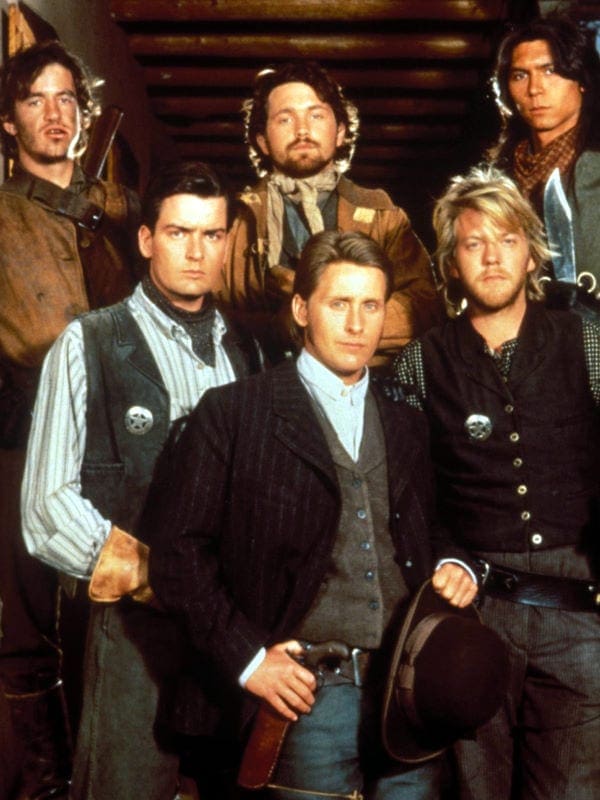
REVIEWS
“A cowboys-as-hunks adventure” – Rutland Herald
"The clubby atmosphere of the Brat Pack western Young Guns is so thick it's almost suffocating." – The Washington Post
Variety called it, “a lame attempt at a Brat Pack Wild Bunch.” It also wrongly predicted, “A short ride at the b.o. seems in store.”
"Hollywood's first heavy-metal western." - Emilio Estevez
Many reviewers had a real issue with the score. Variety summed it up like this: "What this film has that few, if any, Westerns ever have had before is a hard rock score. Music’s every appearance on the scene throws one right out of the scene and serves to remind that this is a high-tech artifact of the late 1980s.”
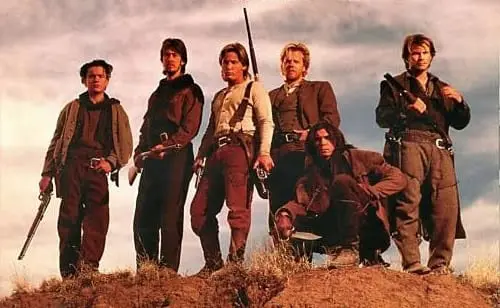
LEGACY
More than 50 movie and TV shows have been made about or featuring Billy the Kid. He is arguably the historical character who has been the subject of the most films. Young Guns is considered the most successful and the most accurate movie to depict Billy the Kid and the Lincoln County War.
Young Guns was awarded the Bronze Wrangler, presented annually by the National Cowboy & Western Heritage Museum to honor the top works n Western music, film, television and literature.
Young Guns II was just as big of a hit as the original, both raking in approximately $45 million. The second is best known for the feature film debut of Jon Bon Jovi and his massive hit single, “Blaze of Glory.”
Billy the Kid showed up the next year in Bill & Ted’s Excellent Adventure (1989). Also in 1989, Val Kilmer starred in a TV movie that focused on what happened after Young Guns: the falsely promised pardon made by the Governor of New Mexico. (Young Guns II also revolves around this.)
Both Dermot Mulroney and Charlie Sheen tried to convince Fusco and Cain to bring them back for Young Guns II, even though their characters died in the first film. Recently, Mulroney said of all the characters he’s played through his career, the one he’d most like to revisit is Dirty Steve.
Charlie Sheen really wanted to come back to do the second film. James Robinson, the head of Morgan Creek Productions, even called Fusco to see if there was a way Sheen could be in the film. Of course, Sheen’s character is killed in Young Guns in a very shocking moment and he is very, very dead. Additionally, Dick Brewer really did die at the hand of Buckshot Roberts. So, Fusco put his foot down. Sheen still came to the set to join in the camaraderie, even though he was not on camera. Apparently, Sheen was more of a rabble-rouser than he was on the first film, and would shepherd wild weekend trips to Mexico.
At the same time, Sheen did an interview in 1990 that expressed some regret in doing Young Guns immediately after his star-making turn in Wall Street, feeling an ensemble film wasn’t beneficial to his career. He told the Chicago Tribune, “I look back now and see that I went into three co-starring bit parts after ``Wall Street`` and they were awful career moves. Maybe I was afraid of what would happen, with how successful I could have become.”
Young Guns inspired two similarly themed films: Posse (1993) with a black cast and Bad Girls, a feminist version. It also is credited for bringing back the western. Lou Diamond Phillips said, “Unforgiven [1992] didn’t happen until us, nor did Silverado [actually, Silverado was 1985. He might have meant Tombstone (1993) - Ed.]. I’m proud to say that Young Guns was responsible for opening the door for those films because it showed that the Western could make money again. They injected this MTV sensibility into it.”
Some of Charlie's dialogue is sampled in the 1994 song “Regulate” by Warren G. and Nate Dogg. Warren G. has said he’s a “geek for Young Guns trivia.” He also contributed to the 2016 Kickstarter campaign to release the Young Guns soundtrack.
Republicans came up with an effort to prevent President Obama from succeeding, calling it “The Young Guns” program. Here’s the Wikipedia description of the effort: “Founded in the 2007–2008 election cycle by Congressmen Eric Cantor, Kevin McCarthy and Paul Ryan, the Young Guns program began as an organization of House Republicans dedicated to electing open seat and challenger candidates nationwide. The Young Guns fostered a strategy of opposing anything proposed by President Obama and earned the Republican Party moniker ‘The Party of No.’”
Kiefer Sutherland rode horseback in Young Guns and it led him to take a career diversion. “When I finished the Young Guns picture, I ended up moving to Montana and started raising horses. And then, instead of just simply raising ranch horses, I started raising roping horses because I had gotten into that. And, again, I was really lucky because I had a natural affinity for it. So it was something that I tried to follow through with and get better at. It was just something that I really loved doing." [Following his film The Cowboy Way, Sutherland took up rodeo riding and won a title. He has since retired from his career as a professional cowboy.]
If Alex McSween looks familiar, you likely watched the ABC hit series “Lost.” A now bald Terry O’Quinn played John Locke.
Emilio Estevez said in 2011 that since he was only working as an actor in Young Guns, he has no control over what and how 20th Century Fox reboots it.
Although maybe he should. The actor was recently named Hollywood’s most profitable actor, meaning that Estevez’ movies consistently brought in more box office dollars than any other actor.
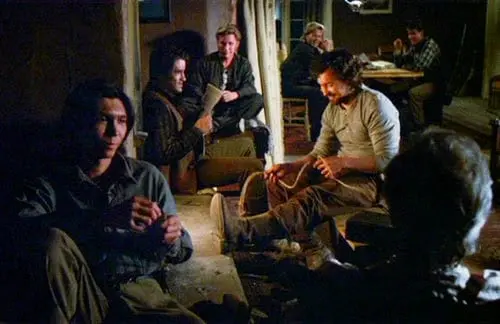
THE YOUNG GUNS TODAY
Fusco said he’s been drawn to the concept of deep relationships among men, such as the Texas Rangers, and the Wulin martial fraternity – and for a while, he lived it. “For me, the making of Young Guns, especially because we got to do it twice with the sequel, and we were pretty much living together for three years riding around New Mexico on horseback, going down across the border and getting into trouble with Charlie Sheen… that really became that kind of experience for me. Those guys were my posse for a long time.”
Mulroney said the film’s appeal lies in the male friendship. He told Movieweb Young Guns is “a guys' movie, that only has guys in it, and it's about guys. Not just the Western aspect of Young Guns...There was something very masculine, and tough, and it had that group mentality...In that movie...It was there while we were making it, and that came across on screen. I think, it still has that...If you can't put your finger on it, but you are still drawn to that movie...If you are a guy…"
Lou Diamond Phillips on current relationships with the cast: "Dermot and I served on the executive committee for the Academy for quite a bit. Emilio and I, we’re Twitter buddies. [Laughs.] We’re both home gardeners, so I’m picking his brain about that. I’m also very proud of his work as a writer/director," Phillips said. "It’s interesting because you never know when you’re doing something historical. Not in the moment. And you look back at it now, and people are like, 'Oh God, what was it like, hanging with Charlie and Kiefer?' Well, we were young and stupid. [Laughs.] We were just young actors with big dreams.”
John Fusco still owns Chato, the horse Jack Palance rides (also seen in Young Guns II AND The Three Amigos), and the 1879 Colt Lightning Billy the Kid uses in the films. Estevez bought the gun himself for the film. Fusco told Entertainment Weekly, “I was always bugging him to look at it and to hold it, and after our final shot of Young Guns II, he walked up to me, he pulled the gun out of his holster, he twirled it, he handed it to me then walked away… He said, ‘That’s yours. You’ve been bugging me to look at it for so long, take it home.’”
Phillips kept the buffalo skin jacket his character wore.
Mulroney said he knows he’s gotten at least one role because of his work in Young Guns. David Gordon Green cast him in his movie Undertow “largely because of Dirty Steve.”
After the film, Sutherland and Phillips reteamed for Renegades (1989) and Teresa’s Tattoo (1994). Estevez and Sheen, real-life brothers, co-starred again together in Men at Work (1990) and Rated X (2000)
Sutherland said if he were to pick films for a retrospective, Young Guns would be one of them (the others would be The Lost Boys, Dark City, and Melancholia.
The Young Guns score, both praised and derided, wasn’t released for consumer purchase. In 2016, Rusted Wave went to Kickstarter to get it pressed and released. The effort was fully funded, and available for sale on Amazon and iTunes.
Talk of a Young Guns movie or TV show has been circulating for at least a decade. In October 2017, Morgan Creek announced they were actively seeking to reboot it.
"Young Guns has a great following from guys in their thirties now. I’m really proud of being involved in that movie, at that time," said Dermot Mulroney.
Mulroney told Movieweb that he’s discovered there are Young Guns fans who are all about Dirty Steve: "There was a weird fanaticism that went along with that guy, Dirty Steve. It went beyond the movie itself. There is a subset. If you are a member of that subset, I BACK you! I am there 100%!"
Soundtrack
No "soundtrack" really existed for Young Guns, but the score by Anthony Marinelli and Brian Banks is definitely unexpected for a Western. A group rallied in 2016 to finance the release the score to the public and it's now available on Amazon and iTunes.
Director: Christopher Cain
Screenwriter: John Fusco
Release Date: August 12, 1988
Rating: R
Opening Weekend Rank: #1. #2 was Cocktail, #3 was Die Hard. Other new releases were Tucker: The Man and His Dreams (#7), Mac and Me (#14) The Last Temptation of Christ (#23)
Opening Weekend Box Office: $7 million
Lifetime Gross: $45.7 million
Budget: $13 million
Production Company: Morgan Creek Productions
Distributor: Twentieth Century Fox

